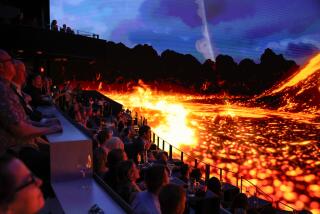Immersion Cinema Makes Splashy Debut
- Share via
WASHINGTON — A cheer rolled across the theater when the movie star’s life was saved. For a change, the cheer was for the audience itself--it was their efforts that cured the actress’ disease.
This summer, visitors to the Smithsonian’s National Museum of Natural History will get to try their hands at diagnosis and cure in the latest of high-tech movie technology: a theater where the audience is part of the show.
For the premiere film, “Vital Space,” computer consoles throughout the theater allow audience members to participate in the show, choosing where to do diagnostic tests and flying through the body’s interior looking for clues to illness.
“It’s part movie, part game,” explained Stacey Spiegel of Toronto, head of Immersion Studios, which developed the system.
“In movies you sit outside the window. This is meant to make you feel that you’re there,” he said.
Indeed, information comes fast and furious on the giant screen and on the 50 television screen-size consoles, which offer multiple controls.
“People learn by living an experience, rather than just observing an object. The Immersion experience is changing the way people learn, work and play together,” said Spiegel. He stressed that audience members sometimes may compete to get one outcome instead of another, while at other times they need to cooperate to succeed.
The film lasts about 15 minutes, but more than triple that amount of material is available and, depending on the audience action, the movie can proceed in 106 different ways.
Immersion Cinema, a compact theater seating about 100 people on the museum’s top floor, opens Tuesday.
While not as massive as the giant IMAX screen a floor below, the angled Immersion screen covers a 145-degree arc, filling the viewer’s peripheral vision from side to side and top to bottom.
The opening show is set in a space station where a crew member becomes ill. The audience is called on to choose which body systems to check first by tapping on the consoles.
Fingers flew as a teenage test audience, youths comfortable with video games, became absorbed in the hunt for illness and, when it was found, the battle to destroy the invading parasite.
It turns from a movie into a game at that point, Spiegel said, asking the audience to tap on weapons such as lasers and chemicals to kill the parasites. If they kill off enough of them, the actress is saved.
“It’s astonishing how emotionally involved audiences get,” Spiegel said. He recalled youngsters bursting into tears when their efforts to protect a marine sanctuary failed at a showing of another film at the Immersion Theater in the New England Aquarium in Boston.
“With the information-gathering style of the Internet and the impact of large-format, state-of-the-art visuals and graphics, the Immersion Cinema will further enhance our ability to educate and entertain,” said Natural History Museum Director Robert Fri.
Spiegel said his company is working with the Natural History Museum to develop future shows for presentation at the computer-operated cinema.
Besides Boston, Immersion theaters are in operation in Montreal, Canada, and Melbourne, Australia.
The theater at the Natural History Museum has five rows of bench seats that can accommodate about 100 adults or up to 120 youngsters.
Spiegel said the primary audience is expected to be children aged 6 to 13 and their parents.
Admission will be $5 for adults, $4.50 for children aged 2 to 17 and adults 55 and older and $3.50 for school groups.
National Museum of Natural History: www.mnh.si.edu
*
Immersion Studios:
www.imm-studios.com
More to Read
The biggest entertainment stories
Get our big stories about Hollywood, film, television, music, arts, culture and more right in your inbox as soon as they publish.
You may occasionally receive promotional content from the Los Angeles Times.










